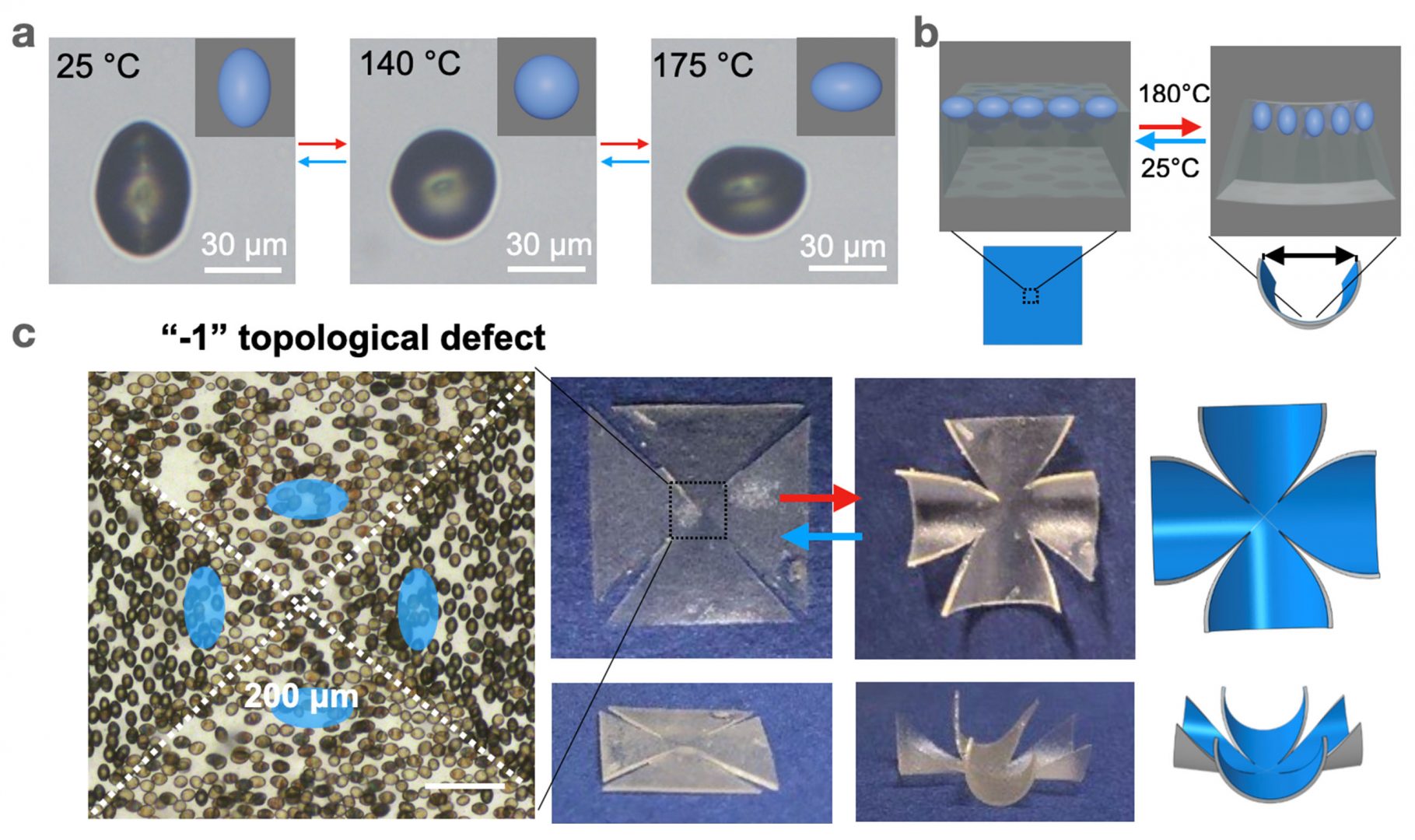Liquid crystal elastomers (LCEs) with intrinsic molecular anisotropy can be preprogrammed to morph shapes from 2D to 3D under external stimuli. However, it is difficult to program the positions and orientations of individual building blocks separately and locally as they are chemically linked in the polymer network.
- Spindle-shaped LCE microparticles are synthesized and show shape changes, from prolate to sphere to oblate, upon heating.
- Magnetic nanoparticles can be incorporated in the microparticles to make them oriented under the magnetic field.
- By combining three strategies (gravity, photopatterning, and use of magnetic field) to program the height distribution and in-plane orientation of the discrete, dually responsive LCE microparticles in a conventional and non-responsive matrix, we can simultaneously program the out-of-plane and in-plane bending spatially, leading to complex shape morphing, including a negative Gaussian curvature, opening of four distinct flower “pedals”, a “crawler”, and a bumpy surface.
- The spatially encoded assemblies from discrete LCE microparticles enriches the IRG goal, that is transcend the structure and function of translationally periodic assemblies beyond perfect.

Fig. 1. (a) Optical images of a temperature responsive LCE spindle microparticle. (b) Schematic of directed bending of a soft matrix embedded with LCE microparticles. (c) (L) Bright-field microscopy images of the dually responsive LCE microparticles programmed with different orientations under the magnetic field. (M) Photographs of the initially flat sheet that bends along the in-plane directions at 180oC with cuts along the intersections. Cut length: 0.4 cm. (R) Finite element simulations of the bent film. Sample size is 1 cm x 1 1 cm x 200 μm.
What Has Been Achieved: By embedding dually responsive, spindle-shaped micro-actuators from liquid crystal elastomer (LCE) composites, which can reorient under a magnetic field and change the shape upon heating, in a conventional and non-responsive elastomer with programmed height distribution and in-plane orientation in local regions, we show robust and complex shape morphing induced by the cooperative actuations of the locally distributed micro-actuators.
Importance of the Achievement: Liquid crystalline elastomers (LCEs) with pre-aligned liquid crystal mesogens (the building blocks) in the network offer programmable large and reversible deformation upon stimulation. So far, few have shown control of both in-plane and out-of-plane orientations of liquid crystal LC mesogens with complex director fields in the three-dimensional (3D) space, locally and globally. The ability to embed discrete micro-actuators in a matrix film enables the separate and spatial control of complex director fields in-plane and along thickness, which is not possible to decouple when programming LCE film itself. It also allows us to broaden the material palette, where complex shapes can be realized in a conventional, isotropic elastomer with high accuracy, whereas surface anchoring requirement and the underlying substrate, and fabrication defects in LCE films would constrain the precision and degree of programmability. Here, the actuation of the building blocks (LCE microparticles) is rather independent of the matrix, while their spatial arrangement will determine the morphed shapes. Importantly, the actuation of the discrete micro-actuators inside the elastomer is more defect tolerant compared to LC mesogens crosslinked in a continuous matrix as the stress induced by the shape change of a single “defect” micro-actuator can be easily dissipated to the surrounding soft network.
How is the achievement related to the IRG, and how does it help it achieve its goals? The spatially directed assemblies from discrete LCE microparticles enriches the IRG goal, that is transcend the structure and function of translationally periodic assemblies by exploiting additional degrees of design freedom unavailable in atomic systems.
Where the findings are published: Liu, M.Z., Fu, J.M., Yang, S.S., Wang, Y.C., Jin, L.S., Nah, S.H., Gao, Y.C., Ning, Y.F., Murray, C.B. and Yang, S. Janus microdroplets with tunable self-recoverable and switchable reflective structural colors. Advanced Materials 35, 2207985, doi:10.1002/adma.202207985 (2023).
